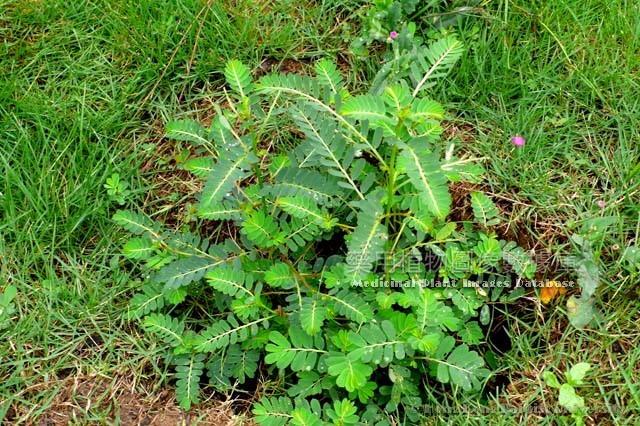|
|
|
Phyllanthus urinaria L.

|
English Name |
Night-closing Leaf, |
|
Latin name |
Phyllanthus urinaria L. |
|
Family & Genus |
Euphorbiaceae, Phyllanthus |
|
Description |
Annual herb that is10-60cm high; stems erect or base procumbent, then ascending, often much branched; branchlets with purplish red, longitudinal ridges with wings, hairless or nearly hairless. Leaves simple and alternate, arranged in two rows, papery, and long elliptic, 5-15mm long, 2-5mm wide, apex blunt, with small convex point, base oblique or rounded, glabrous on both surfaces, with 1-3 rows of coarse short hairs on leaves below, 4-5 lateral veins on each side prominent; very short petiole; stipule small, rigidly hairy or lanceolate with a length of ca. 1.5mm. Small flowers with short stalk unisexual, monoecious and apetalous; male flowers 2-3 fascicled on leaf axils of upper part of branchlets, only one flower on top blossoms, pedicel ca. 0.5mm long, 1-2 bracts at base; sepals 6, oblong, ca. 0.6mm long, apex blunt; stamens 3, filaments connate into column shape; flower disk with 6glands separated; female flowers solitary at the middle and lower part of branchlets, 3mm width, surface covered with small convex thorns or tubercles, pedicel 0.5mm long; sepals 6, subequal in length, ovate-lanceolate or oblong, yellowish white, purplish red in middle part after fruit borne; ovary subglobose, ovary superior, with scalelike bulge, style and apex have 2 clefts. Capsule oblate with 2-3mm diameter, with stripes, persistent style and sepal, light brown or red; seed 1.2mm long, orange-yellow. Flowering: May to October; fruiting: July to November. |
|
Distribution |
Growing on paddy fields, hill-slopes and in roadside grasslands. Distributed in Sichuan, Guizhou, Yunnan, Jiangxi, Zhejiang, Anhui, Hunan, Hubei, Fujian, Taiwan, Hainan, Guangdong and Guangxi. The medicinal materials are mainly produced in Yunnan. |
|
Part Used |
Medical part: mature fruits. Chinese name: Yuganzi. |
|
Harvest & Processing |
Harvested in summer and autumn, removed impurities, used fresh or sundried. |
|
Chemistry |
Contains gallic acid, methylellagic acid, β-sitosterol, succinic acid, daucosterol, camellia, ferulic acid, lignans, quercetin, brevifolinearboxylate, Corilagin, flavones, dehydrochebulic acid, tannin, alkaloids, rutin sophorin, corilagin, ethyl brevifolincarboxylate, methyl brevifolinearboxylate, brevilin, brevifolincarboxylate and trimethyl ester dehydrochebulic acid. |
|
Pharmacology |
Hepatic-protective and anti-bacterial. |
|
Properties & Actions |
Little bitter, cool.Clearing heat-toxin, disinhibiting diuresis for detumescence, suppressing hyperactive liver for improving eyesight and dissipating cyanosis. |
|
Indications & Usage |
Enteritis and diarrhea, retarded growth in infants due to malnutrition, pyretic stranguria, stranguria caused by urinary stones, dysentery with red and white feces, edema due to nephritis, swelling pain induced by conjunctival congestion, caecitas nocturna, sore mouth, venomous snake bites, anthracia, jaundice.Oral administration: decocting, 15-30g; External application: appropriate amount, smashed for applying. Use with caution in cases of deficiency-cold in spleen and stomach. |
|
Examples |
1. Jaundice: fresh night-closing leaf 60g, fresh european verbena 90g, fresh Chinese lobelia 60g, decoct in water and swallow.
2. Hepatitis: fresh night-closing leaf, fresh creeping dichondra herb 60g each, female snail 7, goose liver 1, crystal sugar 60g, stew with water and eat. |
|
Permanent URL:https://sys01.lib.hkbu.edu.hk/cmed/mpid/detail.php?herb_id=D00239 |
|
|
|

